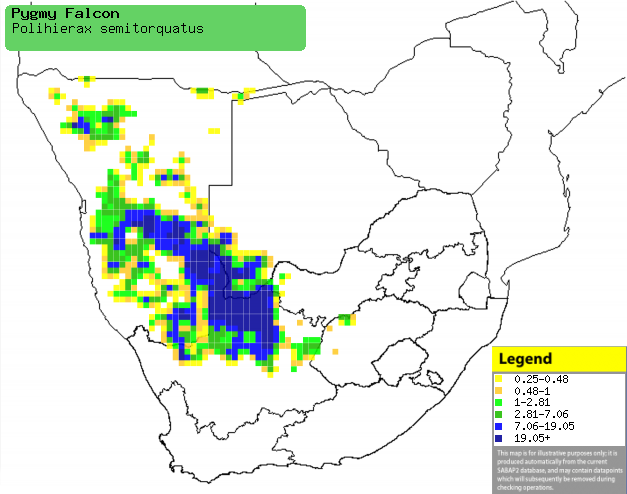|
Polihierax semitorquatus (Pygmy
falcon)
Dwergvalk [Afrikaans]; Afrikaanse dwergvalk, Halsbandvalk
[Dutch]; Fauconnet d'Afrique [French]; Zwergfalke [German]; Falc„o-pigmeu
[Portuguese]
Life
> Eukaryotes >
Opisthokonta
> Metazoa (animals) >
Bilateria >
Deuterostomia > Chordata >
Craniata > Vertebrata (vertebrates) > Gnathostomata (jawed
vertebrates) > Teleostomi (teleost fish) > Osteichthyes (bony fish) > Class:
Sarcopterygii (lobe-finned
fish) > Stegocephalia (terrestrial
vertebrates) > Tetrapoda
(four-legged vertebrates) > Reptiliomorpha > Amniota >
Reptilia (reptiles) >
Romeriida > Diapsida > Archosauromorpha > Archosauria >
Dinosauria
(dinosaurs) > Saurischia > Theropoda (bipedal predatory dinosaurs) >
Coelurosauria > Maniraptora > Aves
(birds) > Order: Falconiformes >
Family: Falconidae
Distribution and habitat
It has two separate populations in sub-Saharan Africa, one extending
from Somalia through Ethiopia and Kenya to southern Sudan and Tanzania and the
other in Angola and southern Africa in Namibia, south-western Botswana and the
Northern Cape. Here it's distribution is strongly linked to that of the
Sociable weaver, as it is uses
their communal nests for roosting and nesting (the northerly population has a
similar relationship with buffalo-weavers). It generally favours open, arid
habitats such as desert, dry savanna and open grassland with scattered Camel
thorns (Acacia erioloba).
|
 |
|
Distribution of Pygmy falcon in southern Africa,
based on statistical smoothing of the records from first SA Bird Atlas
Project (©
Animal Demography unit, University of
Cape Town; smoothing by Birgit Erni and Francesca Little). Colours range
from dark blue (most common) through to yellow (least common).
See here for the latest distribution
from the SABAP2. |
Movements and migrations
Largely sedentary, although it may make local
movements in Winter.
Food
It mainly eats reptiles, insects and occasionally rodents,
doing most of it's hunting from a high perch, gliding down to the ground and
pouncing on its prey. It also hawks small birds aerially and raids the
Sociable weaver colonies it
nests in, taking both adults and chicks. The following food items have been
recorded in its diet:
- Vertebrates
- Invertebrates
Breeding
- Usually monogamous and territorial, although multiple breeding pairs may
occupy a single colony of weavers.
- It usually uses a chamber of a large social weaver communal structure as
a nest, either the Sociable
weaver or the Red-billed
bufallo-weaver. About a quarter of all
Sociable weaver nests have
about 3-4 chambers which are allocated to the falcons for roosting and
nesting. It may also use a stand-alone nest of non-communal bird, such as a
White-browed sparrow-weaver,
Cape glossy or
Wattled starling.
- Egg-laying season is from August-March, peaking from October-November.
- It lays 1-4 eggs, which are mainly incubated by the female for about
27-31 days, while the male provides her with food.
- The chicks are mainly fed by the female, although after fledging both
parents provision them food. The young return to the nest regularly after
fledging, making the nestling period difficult to determine; it is though to
be
about 27-40 days.
Threats
Not threatened, although the destruction of weaver nests
might have decreased its numbers in the North-West Province and Free State,
however the spread of utility structures has allowed both it and the
Sociable weaver to head into
otherwise treeless areas, thus counteracting this.
References
-
Hockey PAR, Dean WRJ and Ryan PG 2005. Roberts - Birds of
southern Africa, VIIth ed. The Trustees of the John Voelcker Bird Book
Fund, Cape Town.
|
